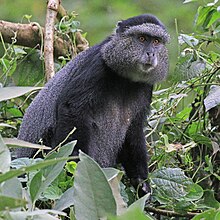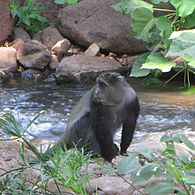| Blue monkey [1] | |
|---|---|

| |
| C. m. stuhlmanni Kakamega Forest, Kenya | |
|
Scientific classification
| |
| Domain: | Eukaryota |
| Kingdom: | Animalia |
| Phylum: | Chordata |
| Class: | Mammalia |
| Order: | Primates |
| Suborder: | Haplorhini |
| Infraorder: | Simiiformes |
| Family: | Cercopithecidae |
| Genus: | Cercopithecus |
| Species: | C. mitis
|
| Binomial name | |
| Cercopithecus mitis
Wolf, 1822
| |
| Subspecies | |
|
6, see text | |

| |
| Range map (note: includes the range of the closely related Sykes', silver, and golden monkey) | |
The blue monkey or diademed monkey (Cercopithecus mitis) is a species of Old World monkey [3] [4] native to Central and East Africa, ranging from the upper Congo River basin east to the East African Rift and south to northern Angola and Zambia. It sometimes includes Sykes', silver, and golden monkeys as subspecies. [1]
Subspecies
Several subspecies are recognised: [1]
- Cercopithecus mitis boutourlinii – Boutourlini's blue monkey, found in Western Ethiopia
- Cercopithecus mitis elgonis – Elgon blue monkey
- Cercopithecus mitis heymansi – Lomami River blue monkey, found in Congo
- Cercopithecus mitis kolbi – Kolb's monkey, found in Kenya
- Cercopithecus mitis mitis – Pluto monkey, found in Angola
- Cercopithecus mitis moloneyi – Moloney's blue monkey [5]
- Cercopithecus mitis opitsthosticus
- Cercopithecus mitis schoutedeni – Schouteden's blue monkey, found in Congo
- Cercopithecus mitis stuhlmanni – Stuhlmann's blue monkey
At times, some of these have been regarded as full species, and additional subspecies have been considered valid, while others are not recognized by all authorities.
-
C. m. stuhlmanni
Kakamega Forest, Kenya -
C. m. stuhlmanni
Kakamega Forest, Kenya
Description
Despite its name, the blue monkey is not noticeably blue; it has little hair on its face, and this does sometimes give a blue appearance, but it never has the vivid blue appearance of a mandrill, for example. It is mainly olive or grey apart from the face (which is dark with a pale or yellowish patch on the forehead – the "diadem" from which the species derives its common name), the blackish cap, feet, and front legs, and the mantle, which is brown, olive, or grey depending on the subspecies. Typical sizes range from 50 to 65 cm in length, (not including the tail, which is almost as long as the rest of the animal), with females weighing a little over 4 kg and males up to 8 kg. [6]
Ecology
Habitat
The blue monkey is found in evergreen forests and montane bamboo forests, and lives largely in the forest canopy, coming to the ground infrequently. It is very dependent on humid, shady areas with plenty of water. It eats mainly fruit and leaves, but will take some slower-moving invertebrates. It prefers to live in tall trees, which provide both food and shelter, and is, therefore, like almost all guenons, suffering from the loss of its natural habitat. Where pine plantations replace natural forest, the monkey may be treated as a threat by foresters, since it sometimes strips bark from exotic trees in a search for food or moisture. [7] It is also hunted for bushmeat.
Diet
Blue monkeys eat fruits, figs, insects, leaves, twigs, and flowers. [8] "They are primarily frugivores, with 50% of their diet consisting of fruit, with leaves or insects as their main source of protein, with the rest of the diet being made up of seeds, flowers, and fungi. They rarely eat vertebrates. They eat a variety of plants, but concentrate on a few species, which means their population density is generally dependent on plant species' richness and diversity". [9]
Behavior
Cercopithecus mitis joins with the C. ascanius ( red-tailed monkey) for extra protection. [10] Its interactions with red-tailed monkeys include interspecies grooming. [11] Their social system is mainly female because the males leave once they are mature. [12] The males have little to no interaction with the young. C. mitis is very territorial, so the young males must leave quickly to help themselves become more successful. They challenge the dominant male of another family. If they defeat the dominant male, they take over the leadership of that family, and this offers a place to live, socialization, and food supplies for the young males." [13] C. mitis is said to be nomadic.
Social structure
The blue monkeys live in female- philopatric social systems where females stay in their natal groups, while males disperse once they reach adulthood. [3] As a result, blue monkey groups usually consist of one male with several females and infants, giving rise to matrilinear societies. [3] [14] [15] Occasionally, solitary males are observed, which are probably transient, having left their natal group in search of a new group. [7] [16] [17]
Social relationships
In these female-bonded societies, only 5–15% of monkeys' activity budget is occupied by social interactions and the most common social interactions within a group are grooming and playing. [14] [15] [18] [19] [20] Relationships between group members vary: infants interact most frequently with their peers and adult or juvenile females [3] and are rarely seen near adult males. [7] [3]
Alloparenting is common among blue monkeys. The most common infant handlers are juvenile females, and usually one infant is carried by a number of alloparents. One hypothesis is that this allows the infant to learn to socialise at an early stage in life. [3]
Interesting female-female relationships exist among blue monkeys. This relationship is believed to be shaped by their feeding ecology, which, in turn, is shaped by between-group and within-group competition. [20] Blue monkey females exhibit strong, aggressive competition between groups [14] [15] [19] and between other species because of their territorial character, [15] [19] but milder though more frequent competition within groups. [15] Though earlier beliefs were that blue monkeys are not territorial, more current extended research [19] shows that earlier researchers misinterpreted the results because social interactions overall are infrequent. Moreover, overall agonism rates in blue monkeys are very low. [15] [20] Within-group conflicts are mild and infrequent because females distance themselves from one another and feed at different sites to avoid competition. [15] [20] Although blue monkeys were believed to be egalitarian, current extended research confirms that linear dominance hierarchy occurs in female blue monkeys, [15] [19] which becomes more apparent when food resources are scarce. [15]
Reproduction
The mating system is polygynous, with a corresponding sexual dimorphism in size, as the males are the substantially larger sex. Females normally give birth every two years, during the onset of the warm, rainy season; gestation is around five months, and the infants are born with fur and with their eyes open. Group sizes range from 10 to 40, containing only a single adult male. It is often found in groups with other species of monkeys such as the red-tailed monkey and various red colobus monkeys. [21]
C. mitis males mate with more than one female, but the females only mate with one male. The female attracts males to copulate with her through body language. They breed throughout the year. [22] "The groups can have up to 40 members and the females usually help to care for all of the young, not just their own." [23]
References
- ^ a b c Groves, C. P. (2005). Wilson, D. E.; Reeder, D. M. (eds.). Mammal Species of the World: A Taxonomic and Geographic Reference (3rd ed.). Baltimore: Johns Hopkins University Press. p. 157. ISBN 0-801-88221-4. OCLC 62265494.
- ^ Butynski, T.M.; de Jong, Y.A. (2019). "Cercopithecus mitis". IUCN Red List of Threatened Species. 2019: e.T4221A196007901. doi: 10.2305/IUCN.UK.2019-3.RLTS.T4221A196007901.en. Retrieved 19 November 2021.
- ^ a b c d e f Förster, Steffen; Cords, Marina (2005). "Socialization of infant blue monkeys (Cercopithecus mitis stuhlmanni): Allomaternal interactions and sex differences". Behaviour. 142 (7): 869–896. doi: 10.1163/1568539055010138. S2CID 85928885.
- ^ Hutchins, M., Kleiman, G.D., Geist, V., McDada, M.C. 2004. Grzimek’s Animal Life Encyclopedia. 14:2. Gale Group.
- ^ "Moloney's White-collared Monkey". IUCN Red List. Accessed 2 September 2019. [1]
- ^ "Blue Monkey in Africa". africa-uganda-business-travel-guide.com. Retrieved 30 May 2020.
- ^ a b c MonkeyWorlds. "Blue Monkey – Monkey Facts and Information". Retrieved 25 May 2020.
- ^ "Blue Monkey (Cercopithecus mitis)." N.p., n.d. Web. 27. Apr. 2016.
- ^ (Samango Monkey Working Group).
- ^ Strawder, Nicole. "Cercopithecus Mitis (blue Monkey)." Animal Diversity Web . N.p., n.d. Web. 27 April 2016.
-
^ Lee, Z.H., Ang, A. & Ruppert, N. (26 August 2021).
"First record of interspecies grooming between Raffles' Banded Langur and Long-tailed Macaque". Journal of Threatened Taxa. 13 (9): 19246–19253.
doi:
10.11609/jott.7510.13.9.19246-19253. Retrieved 5 September 2021.
{{ cite journal}}: CS1 maint: multiple names: authors list ( link) - ^ "Blue Monkey (Cercopithecus mitis)." N.p., n.d. Web. 27 Apr. 2016.
- ^ "Blue Monkey (Cercopithecus mitis)." N.p., n.d. Web. 27 April 2016.
- ^ a b c Cords, Marina (1986). "Interspecific and Intraspecific Variation in Diet of Two Forest Guenons, Cercopithecus ascanius and C. mitis". Journal of Animal Ecology. 55 (3): 811–827. doi: 10.2307/4418. JSTOR 4418.
- ^ a b c d e f g h i Cords, Marina (2002). "Friendship among adult female blue monkeys (Cercopithecus mitis)". Behaviour. 139 (2–3): 291–314. CiteSeerX 10.1.1.505.6980. doi: 10.1163/156853902760102681. S2CID 145357186.
- ^ "Blue monkey". Project Noah. Retrieved 25 May 2020.
- ^ "Blue Monkey". Get to African Wildlife safaris. Retrieved 25 May 2020.
- ^ Gathua JM. 2000. Intraspecific variation in foraging patterns of redtail monkeys (Cercopithecus ascanius) in the Kakamega Forest, Kenya. Dissertation Abstracts International 60-12:A,4497. Columbia University.
- ^ a b c d e Payne, H.F.P.; Lawes, M.J.; Henzi, S.P. (2003). "Fatal Attack on an Adult Female Cercopithecus mitis erythrarchus: Implications for Female Dispersal in Female-Bonded Societies". International Journal of Primatology. 24 (6): 1245–1250. doi: 10.1023/b:ijop.0000005990.39403.96. S2CID 24628028.
- ^ a b c d Pazol, Karen; Cords, Marina (2005). "Seasonal variation in feeding behavior, competition and female social relationships in a forest dwelling guenon, the blue monkey (Cercopithecus mitis stuhlmanni), in the Kakamega Forest, Kenya". Behavioral Ecology and Sociobiology. 58 (6): 566–577. doi: 10.1007/s00265-005-0953-3. S2CID 25637141.
- ^ Ghiglieri, Michael. East of the Mountains of the Moon: Chimpanzee Society in the African Rain Forest, The Free Press, 1988, pg. 238.
- ^ Strawder, Nicole. "Cercopithecus Mitis (blue Monkey)." Animal Diversity Web . N.p., n.d. Web. 27 April 2016.
- ^ "Blue Monkey (Cercopithecus Mitis). N.p., n.d. Web. 27 April 2016.
- IUCN Red List least concern species
- Guenons
- Mammals of Angola
- Mammals of Burundi
- Mammals of the Democratic Republic of the Congo
- Mammals of Ethiopia
- Mammals of Kenya
- Mammals of Malawi
- Mammals of Mozambique
- Mammals of Rwanda
- Mammals of Somalia
- Mammals of South Africa
- Mammals of South Sudan
- Mammals of Eswatini
- Mammals of Tanzania
- Mammals of Uganda
- Mammals of Zambia
- Mammals of Zimbabwe
- Mammals of Sudan
- Mammals described in 1822
- Taxa named by Johann Wolf




